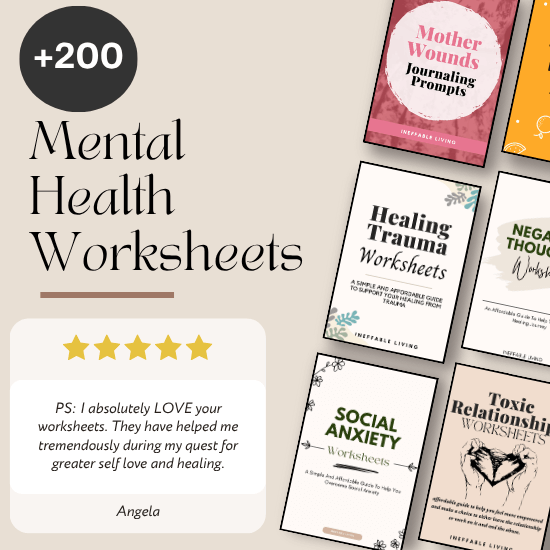Mental health worksheets are designed to help—but sometimes, they can stir up emotions you weren’t prepared for. You might feel overwhelmed, triggered, sad, or even discouraged after filling one out. That doesn’t mean you’ve failed, and it doesn’t mean worksheets aren’t right for you. It just means your mind and body are reacting to what’s being uncovered. Here’s how to respond with care and intention when worksheets feel like too much.
What to Do If Worksheets Make You Feel Worse?
1. Pause and Acknowledge What Came Up
If a worksheet makes you feel worse, don’t push forward. Pause. Name what you’re feeling—whether it’s anger, shame, grief, or confusion. Validating your emotional reaction is the first step in soothing it.
2. Don’t Force Completion
You’re allowed to stop halfway through a worksheet. If something feels too intense or destabilizing, it’s okay to close it for now. Healing isn’t a race—your nervous system’s safety comes first.
3. Switch to a Grounding Worksheet
If deeper prompts feel overwhelming, shift to something gentler. Try a grounding worksheet, a body scan, or a 5-4-3-2-1 sensory exercise. These help bring you back to the present and regulate your emotional state.
4. Use Emotion as a Signal, Not a Sign of Failure
Feeling worse doesn’t mean the worksheet “didn’t work”—it might mean it touched something real. Worksheets often uncover buried emotions, and those feelings are valid. It’s okay if it gets messy before it gets clear.
Related: Burned Out and Overwhelmed? These Worksheets Help You Reclaim Your Mental Health
5. Journal Freely Instead
If a structured worksheet feels too tight or triggering, try freewriting instead. Give yourself space to express what came up without needing to follow a prompt. Sometimes structure is helpful—other times, freedom is healing.
6. Talk It Through With a Therapist
If a worksheet brings up past trauma, intrusive thoughts, or intense emotional responses, bring it to a therapist or trusted professional. What feels too heavy to carry alone might be exactly what’s ready to be held in a safe space.
7. Set Boundaries With Your Healing
You don’t need to “do the deep work” every day. Some days are for growth; others are for rest. Learn to recognize when you’re emotionally resourced to do a worksheet—and when you’re not.
8. Choose Worksheets That Meet You Where You Are
Not every worksheet is right for every stage of healing. If you’re feeling fragile, skip trauma deep-dives or cognitive restructuring and focus on gentler practices like self-soothing, self-validation, or gratitude.
Related: Carrying Old Wounds? These Worksheets Help You Start Healing Your Trauma
What to Do After Filling Out a Worksheet?
1. Take a Moment to Pause
Before jumping into the next task, pause. Sit with what you just uncovered. Give yourself space to breathe, notice how your body feels, and honor whatever emotions surfaced.
2. Read Over What You Wrote
Go back and review your responses slowly. Ask yourself: What stands out? What surprised me? What feels unresolved? This helps you process more deeply instead of rushing past important insights.
3. Write a Brief Reflection
Take a few minutes to jot down:
- What did I learn about myself?
- What do I want to remember from this?
- What do I want to do differently moving forward?
Even a few lines of reflection can solidify your growth and make it stick.
4. Identify One Small Action
Healing doesn’t require huge steps. Look at your worksheet and choose one small thing you can act on—like setting a boundary, practicing a calming technique, or challenging one unhelpful thought.
Related: Feel Like You Can’t Move Forward? These Worksheets Help You Get Unstuck
5. Practice Self-Compassion
Whether your worksheet felt empowering or emotionally heavy, meet yourself with kindness. Avoid self-criticism. Remind yourself: I’m doing the work. I’m showing up for myself. That alone is worth honoring.
6. Ground Yourself if Needed
If the worksheet brought up distressing thoughts or emotions, use a grounding technique afterward:
- Deep breathing
- Cold water splash
- Describing five things you can see and touch
This helps regulate your nervous system and return to the present moment.
7. Save It for Future Reference
Store your worksheet somewhere safe if you want to track progress or revisit your reflections later. Over time, you may notice patterns, themes, or areas of growth you didn’t see at first.
8. Consider Sharing It in Therapy
If you’re working with a therapist, bring your completed worksheet into a session. It can deepen your conversations, clarify goals, and provide context that supports your healing process.
Related: Never Feel Good Enough? These Worksheets Can Help You Build Real Self-Love

Conclusion
Worksheets are tools—not tests. If they stir up pain, it doesn’t mean you’re doing it wrong. It means you’re human, healing, and uncovering what’s been hidden. Go slow. Be kind. And remember: it’s okay to take a break, shift gears, or ask for help. Your safety and softness matter more than any worksheet ever will.